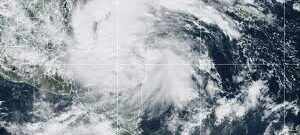Tropical Storm Sara Hits Honduras, Threatens Floods in Central America and Mexico
Tropical Storm Sara has intensified as it hits Honduras, causing widespread concern across Central America and Mexico. The storm has been categorized as a significant weather event, with heavy rains and strong winds battering the region. As the storm progresses, authorities have issued alerts for potential flooding and landslides. Sara is expected to bring torrential rains that could lead to major disruptions, especially in areas that are already prone to such natural disasters. The storm’s movement is also predicted to affect neighboring countries, particularly El Salvador and Guatemala.
Storm’s Impact and Forecasted Path
The storm made landfall in Honduras, where the initial impact has been felt in the form of flooding, power outages, and significant damage to infrastructure. As Sara moves northward, it is expected to continue affecting the Central American region, with Mexico also on high alert. The meteorological services are closely monitoring its path as it strengthens. In addition to flooding, there is a growing risk of landslides, which pose a major threat to communities situated in mountainous areas.
Preparedness and Response Measures in Affected Regions
Local authorities in Honduras, as well as neighboring countries, have ramped up emergency response measures. Evacuations are underway in several high-risk areas, and shelters have been opened to accommodate displaced individuals. The government, along with international organizations, is mobilizing resources to provide immediate relief. These efforts include distributing food, water, and medical supplies to affected communities. Additionally, infrastructure repairs and the restoration of utilities are a priority to ensure quick recovery after the storm passes.

Why This News is Important
Tropical Storms and Their Economic and Social Impact
The threat posed by Tropical Storm Sara highlights the vulnerability of countries in the Caribbean and Central America to frequent weather events. These storms can lead to widespread damage to infrastructure, disrupt economies, and affect millions of lives. In particular, the tourism industry, which is a key economic contributor in many Central American nations, often faces significant setbacks due to such events. Furthermore, the cost of recovery can drain resources, exacerbating financial challenges faced by governments in the region.
Impact on Global Weather Patterns and Climate Change
The severity of tropical storms like Sara also underscores the growing concern over climate change and its influence on weather patterns. Scientists have linked the increase in such storms to rising ocean temperatures, which provide the fuel necessary for these weather systems to intensify. Monitoring such storms becomes increasingly important for not only regional preparedness but also for understanding global weather trends and preparing for future natural disasters.
Implications for Disaster Preparedness and Policy
For students preparing for government exams, this news highlights the importance of disaster preparedness and response mechanisms. Countries with frequent natural disasters need robust policies in place to mitigate damage and ensure effective recovery. It also underscores the importance of regional cooperation when dealing with cross-border environmental issues like tropical storms.
Historical Context: Background Information
Tropical Storms in the Region
Central America and the Caribbean are frequently affected by tropical storms and hurricanes, especially during the hurricane season, which runs from June to November. In 1998, Hurricane Mitch devastated Honduras and neighboring countries, causing extensive loss of life and economic damage. This event led to significant changes in disaster management strategies across the region. Efforts to improve early warning systems, infrastructure resilience, and response capabilities have been ongoing since then.
Recent Natural Disasters in Central America and Mexico
In recent years, countries in the region have faced several severe weather events, including hurricanes, tropical storms, and flooding. For instance, Hurricane Eta and Iota in 2020 caused massive destruction in Honduras, Guatemala, and Nicaragua. These disasters prompted stronger international cooperation for disaster relief and recovery. Countries are now increasingly focusing on strengthening their disaster resilience, especially in vulnerable areas that are prone to flooding and landslides.
Key Takeaways from Tropical Storm Sara
| S. No. | Key Takeaway |
|---|---|
| 1 | Tropical Storm Sara made landfall in Honduras, causing heavy rains and strong winds. |
| 2 | The storm is expected to affect neighboring countries, including Mexico, with potential for floods and landslides. |
| 3 | Emergency response measures include evacuations, establishment of shelters, and distribution of relief supplies. |
| 4 | The storm underscores the vulnerability of Central America and Mexico to natural disasters, emphasizing the importance of disaster preparedness. |
| 5 | The increasing frequency and intensity of storms highlight the need for enhanced disaster resilience and climate change mitigation efforts. |
Important FAQs for Students from this News
What is Tropical Storm Sara?
Tropical Storm Sara is a weather phenomenon that has hit Honduras, causing significant flooding, power outages, and damage to infrastructure. It is forecasted to impact neighboring regions, including Mexico, El Salvador, and Guatemala.
How does Tropical Storm Sara affect Central America and Mexico?
Tropical Storm Sara brings heavy rains and strong winds that can lead to flooding and landslides in vulnerable regions. These weather conditions pose a significant threat to the population, infrastructure, and local economies, especially in mountainous and low-lying areas.
What measures are being taken to respond to the storm?
Local authorities have initiated evacuations in high-risk areas, opened shelters for displaced individuals, and are distributing food, water, and medical supplies. Emergency response teams are working to restore power and infrastructure.
Why is the storm’s path significant for the region?
The storm’s path threatens to cause widespread flooding and landslides across several countries, endangering lives, disrupting economies, and straining emergency response resources. The situation highlights the need for regional disaster preparedness and response.
What is the link between climate change and the intensification of storms like Sara?
Climate change has led to rising ocean temperatures, which provide the energy required for tropical storms to intensify. This makes storms like Sara more frequent and severe, posing a greater risk to affected regions.
Some Important Current Affairs Links


















